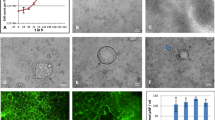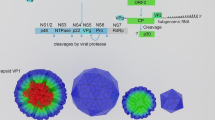Abstract
Human noroviruses (HuNoVs) are a leading cause of acute gastroenteritis. Establishment of a cell culture system for in vitro HuNoV growth remains challenging. Replication of HuNoVs in human intestinal cell lines (INT-407 and Caco-2) that differentiate to produce microvilli in rotation wall vessel (RWV) three-dimensional cultures has been reported (Straub et al. in Emerg Infect Dis 13:396–403, 2007; J Water Health 9:225–240, 2011, and Water Sci Technol 67:863–868, 2013). We used a similar RWV system, intestinal cell lines, and the same (Genogroup [G] I.1) plus additional (GII.4 and GII.12) HuNoV strains to test the system’s reproducibility and to expand the earlier findings. Apical microvilli were observed on the surface of both cell lines by light and electron microscopy. However, none of the cell types tested resulted in productive viral replication of any of the HuNoV strains, as confirmed by plateau or declining viral RNA titers in the supernatants and cell lysates of HuNoV-infected cells, determined by real-time reverse transcription PCR. These trends were the same when culture supplements were added that have been reported to be effective for replication of other fastidious enteric viruses in vitro. Additionally, by confocal microscopy and orthoslice analysis, viral capsid proteins were mainly observed above the actin filament signals, which suggested that the majority of viral antigens were on the cell surface. We conclude that even intestinal cells displaying microvilli were not sufficient to support HuNoV replication under the conditions tested.




Similar content being viewed by others
References
Agus SG, Dolin R, Wyatt RG, Tousimis AJ, Northrup RS (1973) Acute infectious nonbacterial gastroenteritis: intestinal histopathology. Histologic and enzymatic alterations during illness produced by the Norwalk agent in man. Ann Intern Med 79:18–25
Amano J, Oshima M (1999) Expression of the H type 1 blood group antigen during enterocytic differentiation of Caco-2 cells. J Biol Chem 274:21209–21216
Atmar RL, Opekun AR, Gilger MA, Estes MK, Crawford SE, Neill FH, Graham DY (2008) Norwalk virus shedding after experimental human infection. Emerg Infect Dis 14:1553–1557
Atmar RL (2010) Noroviruses—State of the Art. Food Environ Virol 2:117–126
Atmar RL, Estes MK (2012) Norovirus vaccine development: next steps. Expert Rev Vaccines 11:1023–1025
Chan MC, Wong YP, Leung WK (2007) Cell culture assay for human noroviruses. Emerg Infect Dis 13:1117; author reply 1117–1118
Chang KO, Sosnovtsev SV, Belliot G, Kim Y, Saif LJ, Green KY (2004) Bile acids are essential for porcine enteric calicivirus replication in association with down-regulation of signal transducer and activator of transcription 1. Proc Natl Acad Sci USA 101:8733–8738
Chang KO (2009) Role of cholesterol pathways in norovirus replication. J Virol 83:8587–8595
Cheetham S, Souza M, Meulia T, Grimes S, Han MG, Saif LJ (2006) Pathogenesis of a genogroup II human norovirus in gnotobiotic pigs. J Virol 80:10372–10381
Duizer E, Schwab KJ, Neill FH, Atmar RL, Koopmans MP, Estes MK (2004) Laboratory efforts to cultivate noroviruses. J Gen Virol 85:79–87
Finkbeiner SR, Zeng XL, Utama B, Atmar RL, Shroyer NF, Estes MK (2012) Stem cell-derived human intestinal organoids as an infection model for rotaviruses. MBio 3:e00112–e00159
Flynn WT, Saif LJ (1988) Serial propagation of porcine enteric calicivirus-like virus in primary porcine kidney cell cultures. J Clin Microbiol 26:206–212
Green KY (2007) Caliciviridae: the noroviruses. In: Knipe DM, Howley PM (eds) Fields virology. Lippincott Williams & Wilkins, Philadelphia, pp 949–979
Guix S, Asanaka M, Katayama K, Crawford SE, Neill FH, Atmar RL, Estes MK (2007) Norwalk virus RNA is infectious in mammalian cells. J Virol 81:12238–12248
Harrington PR, Lindesmith L, Yount B, Moe CL, Baric RS (2002) Binding of Norwalk virus-like particles to ABH histo-blood group antigens is blocked by antisera from infected human volunteers or experimentally vaccinated mice. J Virol 76:12335–12343
Harrington PR, Vinje J, Moe CL, Baric RS (2004) Norovirus capture with histo-blood group antigens reveals novel virus-ligand interactions. J Virol 78:3035–3045
Herbst-Kralovetz MM, Radtke AL, Lay MK, Hjelm BE, Bolick AN, Sarker SS, Atmar RL, Kingsley DH, Arntzen CJ, Estes MK, Nickerson CA (2013) Lack of norovirus replication and histo-blood group antigen expression in 3-dimensional intestinal epithelial cells. Emerg Infect Dis 19:431–438
Honer zu Bentrup K, Ramamurthy R, Ott CM, Emami K, Nelman-Gonzalez M, Wilson JW, Richter EG, Goodwin TJ, Alexander JS, Pierson DL, Pellis N, Buchanan KL, Nickerson CA (2006) Three-dimensional organotypic models of human colonic epithelium to study the early stages of enteric salmonellosis. Microbes Infect 8:1813–1825
Hutson AM, Atmar RL, Graham DY, Estes MK (2002) Norwalk virus infection and disease is associated with ABO histo-blood group type. J Infect Dis 185:1335–1337
Jung K, Wang Q, Kim Y, Scheuer K, Zhang Z, Shen Q, Chang KO, Saif LJ (2012) The effects of simvastatin or interferon-alpha on infectivity of human norovirus using a gnotobiotic pig model for the study of antivirals. PLoS One 7:e41619
Kageyama T, Kojima S, Shinohara M, Uchida K, Fukushi S, Hoshino FB, Takeda N, Katayama K (2003) Broadly reactive and highly sensitive assay for Norwalk-like viruses based on real-time quantitative reverse transcription-PCR. J Clin Microbiol 41:1548–1557
Klein EJ, Boster DR, Stapp JR, Wells JG, Qin X, Clausen CR, Swerdlow DL, Braden CR, Tarr PI (2006) Diarrhea etiology in a Children’s Hospital Emergency Department: a prospective cohort study. Clin Infect Dis 43:807–813
Lay MK, Atmar RL, Guix S, Bharadwaj U, He H, Neill FH, Sastry KJ, Yao Q, Estes MK (2010) Norwalk virus does not replicate in human macrophages or dendritic cells derived from the peripheral blood of susceptible humans. Virology 406:1–11
Lindesmith L, Moe C, Marionneau S, Ruvoen N, Jiang X, Lindblad L, Stewart P, LePendu J, Baric R (2003) Human susceptibility and resistance to Norwalk virus infection. Nat Med 9:548–553
Liu L, Johnson HL, Cousens S, Perin J, Scott S, Lawn JE, Rudan I, Campbell H, Cibulskis R, Li M, Mathers C, Black RE (2012) Global, regional, and national causes of child mortality: an updated systematic analysis for 2010 with time trends since 2000. Lancet 379:2151–2161
Long JP, Pierson S, Hughes JH (1998) Rhinovirus replication in HeLa cells cultured under conditions of simulated microgravity. Aviat Space Environ Med 69:851–856
Long JP, Hughes JH (2001) Epstein-Barr virus latently infected cells are selectively deleted in simulated-microgravity cultures. In Vitro Cell Dev Biol Anim 37:223–230
Nickerson CA, Goodwin TJ, Terlonge J, Ott CM, Buchanan KL, Uicker WC, Emami K, LeBlanc CL, Ramamurthy R, Clarke MS, Vanderburg CR, Hammond T, Pierson DL (2001) Three-dimensional tissue assemblies: novel models for the study of Salmonella enterica serovar Typhimurium pathogenesis. Infect Immun 69:7106–7120
Papafragkou E, Hewitt J, Park GW, Greening G, Vinje J (2013) Challenges of culturing human norovirus in three-dimensional organoid intestinal cell culture models. PLoS One 8:e63485
Parwani AV, Flynn WT, Gadfield KL, Saif LJ (1991) Serial propagation of porcine enteric calicivirus in a continuous cell line. Effect of medium supplementation with intestinal contents or enzymes. Arch Virol 120:115–122
Patel MM, Widdowson MA, Glass RI, Akazawa K, Vinje J, Parashar UD (2008) Systematic literature review of role of noroviruses in sporadic gastroenteritis. Emerg Infect Dis 14:1224–1231
Peterson MD, Mooseker MS (1992) Characterization of the enterocyte-like brush border cytoskeleton of the C2BBe clones of the human intestinal cell line, Caco-2. J Cell Sci 102(Pt 3):581–600
Rondy M, Koopmans M, Rotsaert C, Van Loon T, Beljaars B, Van Dijk G, Siebenga J, Svraka S, Rossen JW, Teunis P, Van Pelt W, Verhoef L (2011) Norovirus disease associated with excess mortality and use of statins: a retrospective cohort study of an outbreak following a pilgrimage to Lourdes. Epidemiol Infect 139:453–463
Sainz B Jr, Barretto N, Uprichard SL (2009) Hepatitis C virus infection in phenotypically distinct Huh7 cell lines. PLoS One 4:e6561
Sainz B Jr, TenCate V, Uprichard SL (2009) Three-dimensional Huh7 cell culture system for the study of Hepatitis C virus infection. Virol J 6:103
Scallan E, Hoekstra RM, Angulo FJ, Tauxe RV, Widdowson MA, Roy SL, Jones JL, Griffin PM (2011) Foodborne illness acquired in the United States—major pathogens. Emerg Infect Dis 17:7–15
Straub TM, Honer zu Bentrup K, Orosz-Coghlan P, Dohnalkova A, Mayer BK, Bartholomew RA, Valdez CO, Bruckner-Lea CJ, Gerba CP, Abbaszadegan M, Nickerson CA (2007) In vitro cell culture infectivity assay for human noroviruses. Emerg Infect Dis 13:396–403
Straub TM, Bartholomew RA, Valdez CO, Valentine NB, Dohnalkova A, Ozanich RM, Bruckner-Lea CJ, Call DR (2011) Human norovirus infection of caco-2 cells grown as a three-dimensional tissue structure. J Water Health 9:225–240
Straub TM, Hutchison JR, Bartholomew RA, Valdez CO, Valentine NB, Dohnalkova A, Ozanich RM, Bruckner-Lea CJ (2013) Defining cell culture conditions to improve human norovirus infectivity assays. Water Sci Technol 67:863–868
Takahashi K, Yamanaka S (2006) Induction of pluripotent stem cells from mouse embryonic and adult fibroblast cultures by defined factors. Cell 126:663–676
Takanashi S, Wang Q, Chen N, Shen Q, Jung K, Zhang Z, Yokoyama M, Lindesmith LC, Baric RS, Saif LJ (2011) Characterization of emerging GII.g/GII.12 noroviruses from a gastroenteritis outbreak in the United States in 2010. J Clin Microbiol 49:3234–3244
Thorven M, Grahn A, Hedlund KO, Johansson H, Wahlfrid C, Larson G, Svensson L (2005) A homozygous nonsense mutation (428G–>A) in the human secretor (FUT2) gene provides resistance to symptomatic norovirus (GGII) infections. J Virol 79:15351–15355
Wobus CE, Thackray LB, Virgin HW 4th (2006) Murine norovirus: a model system to study norovirus biology and pathogenesis. J Virol 80:5104–5112
Yan H, Yagyu F, Okitsu S, Nishio O, Ushijima H (2003) Detection of norovirus (GI, GII), Sapovirus and astrovirus in fecal samples using reverse transcription single-round multiplex PCR. J Virol Methods 114:37–44
Yan HNT, Phan TG, Okitsu S, Li Y, Ushijima H (2004) Development of RT-multiplex PCR assay for detection of adenovirus and group A and C rotaviruses in diarrheal fecal specimens from children in China. Kansenshogaku Zasshi 78:699–709
Zheng DP, Ando T, Fankhauser RL, Beard RS, Glass RI, Monroe SS (2006) Norovirus classification and proposed strain nomenclature. Virology 346:312–323
Acknowledgments
We thank Juliette Hanson and Kingsly Berlin for assistance with animal care, Andrea Kaszas for assistance with microscopic examination, and Tomoichiro Oka for helpful discussions. This work was supported by a grant from the National Institute of Allergy and Infectious Diseases, National Institutes of Health (R21 AI081009-2). Salaries and research support were provided by state and federal funds provided to the Ohio Agricultural Research and Development Center (OARDC), The Ohio State University.
Conflict of interest
The authors declare that they have no conflict of interest.
Author information
Authors and Affiliations
Corresponding author
Rights and permissions
About this article
Cite this article
Takanashi, S., Saif, L.J., Hughes, J.H. et al. Failure of propagation of human norovirus in intestinal epithelial cells with microvilli grown in three-dimensional cultures. Arch Virol 159, 257–266 (2014). https://doi.org/10.1007/s00705-013-1806-4
Received:
Accepted:
Published:
Issue Date:
DOI: https://doi.org/10.1007/s00705-013-1806-4




